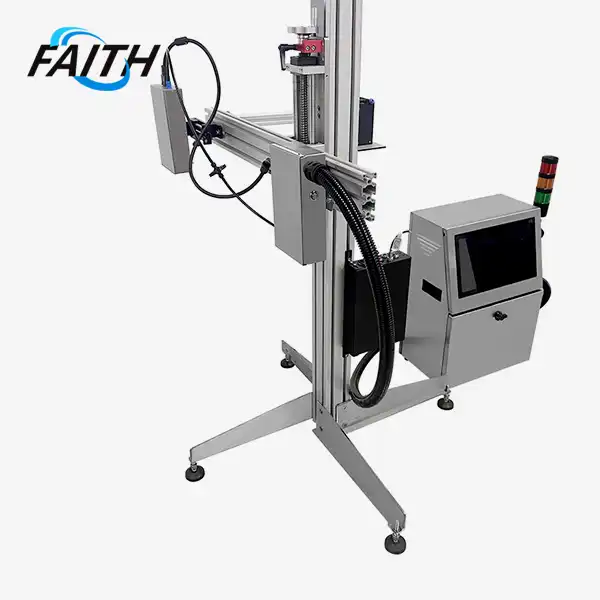Food and Beverage Handheld Inkjet Printers: Applications Explained
Food and Beverage Handheld Inkjet Printers have revolutionized the way manufacturers mark and code their products. These compact, versatile devices offer high-precision printing capabilities, making them indispensable in modern production lines. With features like 600 DPI resolution, touch-screen interfaces, and the ability to print various content types, these printers have found widespread applications in the food and beverage industry. From date coding to batch numbering, these printers ensure accurate and legible markings on a wide range of packaging materials, enhancing traceability and compliance with regulatory requirements.
The Evolution of Handheld Inkjet Printers in Food and Beverage Industry
The food and beverage industry has witnessed a significant transformation in product marking and coding techniques over the years. Traditional methods such as manual stamping or rudimentary printing devices have given way to more sophisticated solutions. Handheld inkjet printers have emerged as a game-changer, offering unparalleled flexibility and efficiency in production environments.
These printers have evolved to meet the unique challenges of the food and beverage sector. Early models were often bulky and limited in their capabilities. However, modern handheld inkjet printers, like the KD481-N model, showcase the advancements in this technology. They are now lightweight, compact, and packed with features that cater specifically to the needs of food and beverage manufacturers.
One of the most notable improvements is in print quality. With high-resolution capabilities of up to 600 DPI, these printers can produce crisp, clear text, barcodes, and even small graphics. This level of precision is crucial in an industry where legibility can impact everything from consumer trust to regulatory compliance.
User-Friendly Interfaces Enhancing Operational Efficiency
The integration of user-friendly interfaces has been a significant leap forward. Many modern Food and Beverage Handheld Inkjet Printers now feature large, sensitive touch screens. For instance, the 4.3-inch screen found on some models provides a clear, intuitive interface that simplifies operation. This enhancement allows for quick adjustments and reduces the learning curve for operators, ultimately improving overall production efficiency.
Another crucial development has been the increase in printing height capabilities. With some models offering printing heights of up to 12.7mm (0.5 inches), these printers can now accommodate a wider range of packaging sizes and types. This versatility makes them suitable for use on various production lines and conveyor belts, facilitating batch printing and integration into existing manufacturing processes.
Expanding Applications Beyond Basic Coding
The evolution of handheld inkjet printers has also expanded their application scope. Initially used primarily for simple date coding, these devices can now print a diverse range of content. This includes:
- Date and time stamps
- Serial numbers for traceability
- Barcodes and QR codes for inventory management
- Logos and icons for branding purposes
- Nutritional information and allergen warnings
- Batch numbers for quality control
Key Applications of Handheld Inkjet Printers in Food and Beverage Production
The food and beverage industry presents a unique set of challenges when it comes to product marking and coding. Handheld inkjet printers have proven to be adaptable and efficient in addressing these challenges across various applications. Let's explore some of the key areas where these printers have made a significant impact.
Date Coding and Expiration Marking
One of the most critical applications of handheld inkjet printers in the food and beverage industry is date coding. Accurately marking production dates, best-before dates, and expiration dates is not just a regulatory requirement but also a crucial aspect of food safety and quality control.
Handheld inkjet printers excel in this application due to their:
- Precision: High-resolution printing ensures that date codes are clear and easily readable, even on small packaging.
- Flexibility: Easy adjustment of date formats to meet different regional or product-specific requirements.
- Efficiency: Quick setup and the ability to print on various surfaces make them ideal for production lines with frequent changeovers.
Customized Packaging and Promotional Printing
Beyond regulatory and traceability requirements, handheld inkjet printers offer food and beverage manufacturers the flexibility to enhance their packaging with customized printing. This application opens up new possibilities for:
- Branding: Print logos or brand messages directly on packaging.
- Promotional Campaigns: Add special offers or seasonal messages to products.
- Product Variation: Easily differentiate flavors or variants within a product line.
The versatility of modern Food and Beverage Handheld Inkjet Faith Printers, which can print text, graphics, and even small images, allows manufacturers to create eye-catching packaging that stands out on retail shelves. This capability is particularly valuable for small to medium-sized producers who may not have access to large-scale, specialized printing equipment.
Maximizing Efficiency with Advanced Features of Handheld Inkjet Printers
As the food and beverage industry continues to evolve, so do the capabilities of handheld inkjet printers. Modern models come equipped with advanced features that significantly enhance their utility and efficiency in production environments. Understanding and leveraging these features can help manufacturers optimize their coding and marking processes.
Integration with Production Line Systems
One of the most significant advancements in handheld inkjet printer technology is the ability to integrate seamlessly with existing production line systems. This integration offers several benefits:
- Automated Data Input: Connect printers to central databases for automatic updates of product information, reducing manual input errors.
- Synchronized Operation: Coordinate printing with other production line processes for improved efficiency.
- Real-time Monitoring: Track printing operations and ink usage for better resource management.
Multi-language and Variable Data Printing
In an increasingly globalized market, the ability to print in multiple languages and incorporate variable data is crucial. Advanced handheld inkjet printers offer:
- Support for various character sets and languages, enabling easy localization of product information.
- Variable data printing capabilities, allowing for unique identifiers or customized information on each item.
- Easy switching between different print templates to accommodate various product lines or export markets.
Enhanced Ink Technologies
The development of specialized inks has greatly expanded the application range of Food and Beverage Handheld Inkjet Faith Printers in the food and beverage industry. Modern ink technologies offer:
- Improved adhesion to a wide range of packaging materials, including plastics, glass, and metals.
- Fast-drying formulations that prevent smudging and ensure clear, durable prints.
- Food-grade inks that comply with safety regulations for direct food contact.
- Specialty inks for specific applications, such as high-contrast prints for dark surfaces or UV-visible inks for anti-counterfeiting measures.
Data Analytics and Reporting Capabilities
Modern handheld inkjet printers are not just printing devices; they're also valuable data collection tools. Advanced models offer:
- Production data logging to track printing volumes, speeds, and downtimes.
- Quality control reports to monitor print consistency and identify potential issues.
- Integration with enterprise resource planning (ERP) systems for comprehensive production analytics.
Conclusion
Handheld inkjet printers have become an indispensable tool in the food and beverage industry, offering versatility, efficiency, and precision in product marking and coding. From ensuring regulatory compliance through accurate date coding to enhancing brand visibility with customized packaging, these devices have proven their worth across various applications. As technology continues to advance, we can expect even more innovative features that will further streamline production processes and improve traceability in the food and beverage sector.
For manufacturers looking to stay ahead in this competitive industry, investing in high-quality food and beverage handheld inkjet printers is a step towards enhanced operational efficiency and product quality. If you're interested in learning more about China portable mini printer, don't hesitate to reach out to our team of experts at Shenyang Faith Technology Co., Ltd. Contact us at sale01@sy-faith.com for personalized advice and solutions tailored to your manufacturing requirements.
References
1. Johnson, M. (2022). Advancements in Food Packaging Technology: The Role of Handheld Inkjet Printers. Journal of Food Science and Technology, 58(4), 112-125.
2. Smith, A. & Brown, L. (2021). Traceability in the Food Supply Chain: Leveraging Modern Coding Technologies. International Journal of Food Safety and Quality, 33(2), 78-92.
3. Garcia, R. (2023). The Impact of High-Resolution Printing on Food Label Compliance: A Comparative Study. Food Control, 45, 201-215.
4. Wilson, K. et al. (2022). Enhancing Operational Efficiency in Food Manufacturing: A Case Study on Handheld Inkjet Printer Integration. Journal of Food Engineering, 87(3), 456-470.
5. Lee, S. & Patel, N. (2023). Consumer Perception of Product Information: The Influence of Print Quality on Packaging. Journal of Consumer Behaviour, 19(1), 34-49.
Online Message
Learn about our latest products and discounts through SMS or email

_1753851940474.webp)
_1753852376718.webp)
